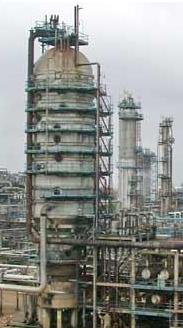Vacuum distillation
Vacuum distillation is a method of distillation performed under reduced pressure, which lowers the boiling point of most liquids. This technique is particularly useful for separating compounds that are heat-sensitive or that would decompose at their normal boiling points. Vacuum distillation is widely used in both industrial applications, such as the production of petroleum products, and in laboratory settings for purifying organic compounds.
Overview[edit | edit source]
In vacuum distillation, the pressure above a liquid mixture to be distilled is reduced to less than its vapor pressure, causing evaporation of the most volatile liquids. This process is different from simple distillation, where the mixture is heated to boil off the more volatile components at atmospheric pressure. By reducing the pressure, the boiling points of the components are lowered, allowing them to be vaporized at lower temperatures. This is particularly advantageous for compounds that might decompose or react at higher temperatures.
Applications[edit | edit source]
Vacuum distillation has a wide range of applications in both the industrial sector and research laboratories. In the petroleum industry, it is used to distill crude oil into its components, such as gasoline, kerosene, and diesel, at temperatures that prevent thermal cracking. In the pharmaceutical and fine chemical industries, vacuum distillation is employed to purify temperature-sensitive organic compounds. It is also used in the food and beverage industry to remove volatile flavors and aromas without cooking the product.
Equipment[edit | edit source]
The equipment used for vacuum distillation varies depending on the scale and specific requirements of the process. At a basic level, it consists of a distillation apparatus connected to a vacuum pump. Laboratory setups often use a rotary evaporator, while industrial applications may use larger, more complex systems. Key components include a distillation column, condenser, receiver, and vacuum source. Temperature control and monitoring are critical, as is the maintenance of a stable vacuum.
Procedure[edit | edit source]
The procedure for vacuum distillation can be summarized as follows: 1. The mixture to be distilled is placed in the distillation flask. 2. The system is evacuated using a vacuum pump, reducing the pressure below the vapor pressure of the lowest boiling component. 3. The mixture is then gently heated, causing the most volatile component to vaporize. This vapor is drawn into the distillation column. 4. As the vapor rises in the column, it cools and condenses on packing material or trays. The condensate is collected in the receiver as the distillate. 5. The process continues until the desired component has been distilled off. The vacuum may be adjusted to facilitate the distillation of subsequent fractions.
Advantages and Limitations[edit | edit source]
The primary advantage of vacuum distillation is its ability to distill heat-sensitive materials at lower temperatures, thus preventing decomposition. This method also allows for the separation of compounds with very close boiling points, which might not be possible under atmospheric pressure.
However, vacuum distillation also has limitations. It requires specialized equipment that can maintain a stable vacuum and control temperatures precisely. The process can be slower than simple distillation due to the reduced pressure and lower heat input. Additionally, some compounds may have very similar boiling points even under vacuum, making separation difficult.
Conclusion[edit | edit source]
Vacuum distillation is a valuable technique in both industrial and laboratory settings, offering a means to separate and purify compounds that would be challenging to handle by other methods. Its ability to operate at lower temperatures opens up possibilities for processing heat-sensitive materials and achieving separations that are not feasible at atmospheric pressure.
| This article is a stub. You can help WikiMD by registering to expand it. |
Search WikiMD
Ad.Tired of being Overweight? Try W8MD's physician weight loss program.
Semaglutide (Ozempic / Wegovy and Tirzepatide (Mounjaro / Zepbound) available.
Advertise on WikiMD
|
WikiMD's Wellness Encyclopedia |
| Let Food Be Thy Medicine Medicine Thy Food - Hippocrates |
Translate this page: - East Asian
中文,
日本,
한국어,
South Asian
हिन्दी,
தமிழ்,
తెలుగు,
Urdu,
ಕನ್ನಡ,
Southeast Asian
Indonesian,
Vietnamese,
Thai,
မြန်မာဘာသာ,
বাংলা
European
español,
Deutsch,
français,
Greek,
português do Brasil,
polski,
română,
русский,
Nederlands,
norsk,
svenska,
suomi,
Italian
Middle Eastern & African
عربى,
Turkish,
Persian,
Hebrew,
Afrikaans,
isiZulu,
Kiswahili,
Other
Bulgarian,
Hungarian,
Czech,
Swedish,
മലയാളം,
मराठी,
ਪੰਜਾਬੀ,
ગુજરાતી,
Portuguese,
Ukrainian
Medical Disclaimer: WikiMD is not a substitute for professional medical advice. The information on WikiMD is provided as an information resource only, may be incorrect, outdated or misleading, and is not to be used or relied on for any diagnostic or treatment purposes. Please consult your health care provider before making any healthcare decisions or for guidance about a specific medical condition. WikiMD expressly disclaims responsibility, and shall have no liability, for any damages, loss, injury, or liability whatsoever suffered as a result of your reliance on the information contained in this site. By visiting this site you agree to the foregoing terms and conditions, which may from time to time be changed or supplemented by WikiMD. If you do not agree to the foregoing terms and conditions, you should not enter or use this site. See full disclaimer.
Credits:Most images are courtesy of Wikimedia commons, and templates, categories Wikipedia, licensed under CC BY SA or similar.
Contributors: Prab R. Tumpati, MD




